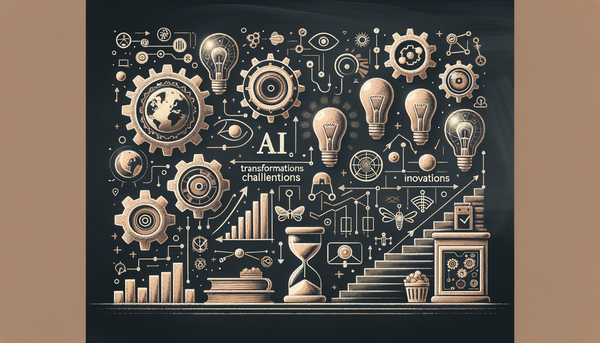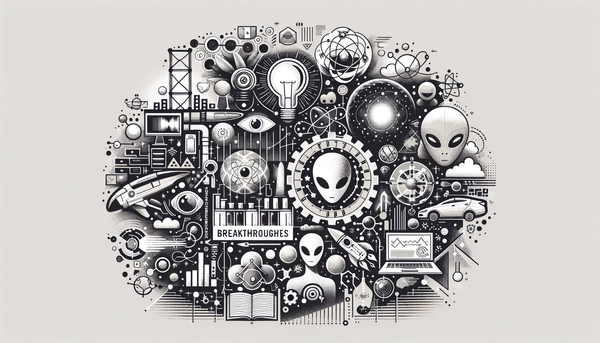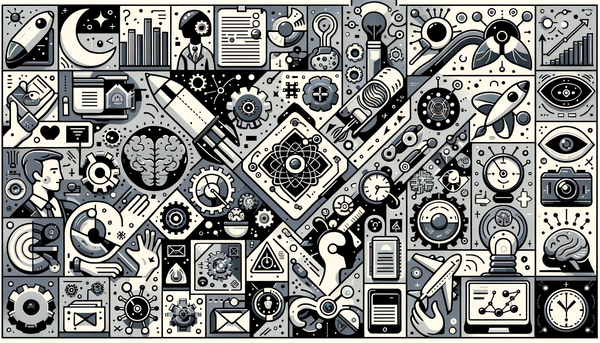AI Updates: From Global Regulations to Protein Design
The rapidly evolving AI landscape is being reshaped by global regulatory frameworks, breakthrough biotech ventures, and innovative digital tools that bridge regulatory gaps. In this in-depth overview, we explore discussions from the AI Action Summit on how a balanced regulatory approach can spur innovation, examine an exciting new startup led by former DeepMind employees that is redefining protein design with a $40 million infusion, and delve into the transformative potential of CODIT’s AI-powered English Policy Dashboard for tracking Korean regulatory changes. Together, these developments provide a rich tapestry of how artificial intelligence is not only revolutionizing industries but also catalyzing new discussions about accountability, global collaboration, and cutting-edge technological applications.
Global AI Regulations: Striking the Right Balance
The digital revolution powered by artificial intelligence is prompting unprecedented collaborative efforts among global leaders. At the AI Action Summit, thought leaders, policymakers, and innovators gathered to discuss AI regulations that will shape the future. What emerged from this intense dialogue was a shared vision: a regulatory framework that both safeguards society while liberating technological innovation.
The summit emphasized frameworks that are built on safety and accountability. However, it was equally important for these frameworks to serve as catalysts for growth. In an era where technological breakthroughs can upscale industries overnight, rigid regulatory models may stifle potential. Instead, a balanced approach that rewards innovation while ensuring ethical safeguards is hailed as paramount for continued progress.
This perspective was echoed by many experts who have noted that effective regulation is not about hindering technology but nurturing it. One participant aptly compared the scenario to tending a garden: a balance between fertile soil and well-timed pruning leads to a vibrant, thriving ecosystem. This analogy underscores that while regulations are necessary to prevent unchecked risks, they should also function as an enabler for growth.
"More human than human is our motto." – Eldon Tyrell, Blade Runner
Drawing from historical trends, one may recall how the early industrial era was marked by a similar tension between regulation and rapid innovation. Much like the regulatory challenges faced by nascent industries then, today's AI leaders are advocating for policies that strike a balance between discipline and creative freedom.
Across the international stage, countries that have proactively designed their AI policies provide strong case studies. They have shown that a clear, consistent, and forward-looking regulatory framework can attract investments, reduce uncertainty, and foster a dynamic environment for start-ups and established enterprises alike. The lessons learned at the summit can be seen as a call to action for governments worldwide to adopt a more nuanced, flexible regulatory mindset—one that anticipates the rapid evolution of technology rather than merely reacting to it.
For a more detailed discussion on such regulatory developments, you might be interested in exploring our latest AI news podcast updates, which delve further into the interplay between regulation and technological innovation.
Innovative Ventures: AI Revolution in Protein Design
While policy discussions are setting the stage for broad-scale transformation, groundbreaking innovations are also emerging at the ground level. A team of former DeepMind employees recently launched a startup with a formidable $40 million backing, focusing on AI-driven protein design. This move represents a significant leap in applying artificial intelligence to synthetic biology – a field that stands at the frontier of medical and pharmaceutical research.
Proteins are the workhorses of life. They are responsible for a myriad of functions within biological organisms, from catalyzing reactions to supporting cellular structure and transmitting signals. Traditionally, designing proteins has been a laborious process, involving trial and error and substantial human intuition. However, with advances in AI, researchers are now able to predict and design protein structures and functions with unprecedented accuracy and speed.
The new startup, leveraging the extensive expertise of its founders from DeepMind, aims to develop models that can simulate complex protein interactions at molecular levels. This development not only promises to accelerate drug discovery but also highlights the transformative potential AI holds in managing complex biological data. By computationally generating viable protein designs, the technology could dramatically reduce the time and financial investment required in the early stages of drug development.
This breakthrough is particularly exciting in the current context where the worlds of artificial intelligence and biotechnology are converging. The integration of AI in protein design is already making ripples in sectors such as personalized medicine, where quick and affordable development of treatments is a critical need. For instance, AI-driven drug discovery has been instrumental in identifying potential therapeutic candidates during public health crises, a trend that is likely to gain momentum in the coming years.
One expert once asserted, "AI will impact every industry on Earth, including manufacturing, agriculture, health care, and more." This sentiment by Fei-Fei Li aptly captures the scope of the transition we are witnessing. In the context of protein design, the integration of AI not only symbolizes a paradigm shift in biotechnology but also portends a future where personalized treatments and rapid therapeutic innovations become the norm.
Beyond the immediate implications for healthcare, such advancements hold promise for broader applications such as environmental sustainability and industrial biotechnology. For instance, engineered proteins could be optimized to catalyze reactions in biofuel production, thereby offering a sustainable alternative to conventional fuels. The synthesis of such proteins, designed with AI precision, exemplifies how cross-disciplinary innovation is setting the stage for transformative change.
For those intrigued by how similar breakthroughs in AI are unfolding across sectors, our AI news podcast featuring DeepMind breakthroughs offers further insight into the unfolding narrative of AI's disruptive potential.
Bridging Global Regulatory Gaps with AI: The Case of the English Policy Dashboard
In a complementary stride towards harnessing AI for operational excellence, CODIT has unveiled an ingenious tool that tackles the challenge of regulatory compliance on an international scale. Recognizing the intricacies of staying abreast with the rapid evolution of regulations, especially in dynamic markets like Korea, CODIT’s new AI-powered English Policy Dashboard is tailored to help global companies navigate these complexities.
This dashboard is a marvel of modern technology: it leverages AI to translate, synthesize, and monitor evolving policy directions, thereby simplifying what is traditionally a daunting task. For international companies, understanding regulatory changes in a language that might not be their own has always represented a significant challenge. With this tool, however, language barriers are rapidly becoming a relic of the past.
This development aligns with a broader movement across industries where AI is being used to democratize access to critical information. Similar to platforms that convert vast data sets into actionable insights for financial markets or logistics operations, the English Policy Dashboard represents an intersection of legal tech and artificial intelligence. It ensures that businesses are not caught off guard by sudden legislative changes, helping them adjust their strategies in real time.
The dashboard’s capability to provide real-time insights into Korean regulatory changes is especially crucial in an era where global supply chains are increasingly sensitive to local developments. For multinational corporations, staying compliant is not merely a legal requirement—it is an essential component of sustainable operation. This tool exemplifies how AI can serve as an enabler for smoother, more informed interactions between international businesses and local regulatory bodies.
It also opens up conversations about the broader impact of AI in policy and governance. As more governments and regulatory authorities turn to AI to manage and disseminate information, tools like these could become ubiquitous. They could serve as templates for developing similar dashboards tailored to other regulatory environments worldwide, creating a more interconnected and transparent global business ecosystem.
A notable observation here can be tied back to the sentiments expressed at the AI Action Summit. While robust regulations are being systematically curated and refined, technological tools are simultaneously being deployed to help businesses adhere to these new standards. The synergy between technology and regulatory compliance could very well redefine how companies prepare for and respond to legal challenges in an increasingly complex world.
Those interested in the practical aspects of AI-powered regulatory tools might wish to check out our piece on the latest AI news updates for further insights and success stories that illustrate the convergence of policy and technology.
Implications for the AI Ecosystem: Balancing Innovation and Regulation
The developments we have discussed—from global regulatory summits to pioneering startups and an AI-powered policy dashboard—reveal an interconnected ecosystem where every element reinforces the other. This emerging synergy between regulation and innovation is poised to redefine our interaction with technology in fundamental ways.
At its core, AI is not just a tool or trend; it is reshaping the very fabric of industries by introducing new avenues for growth and, simultaneously, new challenges that demand agile and thoughtful regulation. The evolution of AI is often paralleled with historical technological revolutions, such as the advent of electricity or the internet. In each case, robust regulatory frameworks emerged gradually, ensuring that the technology could be harnessed safely while spurring further innovation.
The AI Action Summit's emphasis on the balance between safety and innovation echoes decades-old debates in technology policy. There is an emerging consensus among experts that regulation should be adaptive, enabling rapid advances without compromising fundamental ethical values. A pertinent observation worth noting is reflected in a popular adage: "The coming era of artificial intelligence will not be the era of war, but be the era of deep compassion, non-violence, and love." Such reflective commentary reminds us that regulatory frameworks should also capture the societal values that underlie technological adoption.
The interplay between technology and regulation has tangible implications. For example, the success of the AI protein design startup hinges not only on technical breakthroughs but also on a supportive regulatory environment that encourages swift translation from research to commercialization. Similarly, the utility of CODIT’s dashboard can be greatly enhanced in ecosystems where governments are proactive in adopting and disseminating clear policy guidelines.
In many ways, these developments are mutually reinforcing. A stringent yet enabling regulatory environment encourages venture capital to flow into innovative projects, while successful tech startups provide empirical evidence that aligns with regulatory goals—making a case for further refinement and adoption of supportive policies.
Moreover, the global AI ecosystem is not isolated within its industry boundaries. The ripple effects extend into sectors as diverse as healthcare, manufacturing, logistics, and even creative arts. For instance, consider how AI is now being used for everything from generating art and music to optimizing manufacturing processes. By examining these cross-industry applications, we gain a window into a future where AI-based solutions are seamlessly integrated into daily operations. As businesses look ahead, the ability to balance innovation with regulatory oversight will be the linchpin for sustained economic and societal progress.
This balance is also reflected in our own AI.Biz perspectives, where our coverage spans from high-level regulatory discussions to deep dives into niche innovations. If you're curious to explore various facets of this debate, our AI news podcasts provide an excellent platform to understand the intricate interplay between policy and innovation in real-time discussions.
Global Collaboration and Future Directions
As governments, innovators, and industries strive to navigate the rapidly shifting terrain of AI, one thing remains clear: collaboration is key. Cross-border dialogues, such as those initiated at the AI Action Summit, are essential in shaping a holistic approach to regulation that is applicable at the international level. Such dialogues help neutralize the disparities between local regulatory frameworks, paving the way for a uniform and conducive environment for technology to flourish.
Global cooperation in the realm of AI regulation also extends to collaborative research and development initiatives. The startup focusing on protein design is a testament to how interdisciplinary teams can leverage diverse expertise to solve complex problems. The convergence of ideas from computer science, biotechnology, and regulatory affairs often creates a fertile ground for breakthrough innovations that would be inconceivable within siloed structures.
In look to the horizon, one can imagine a future where AI-powered solutions are ubiquitous in not only transforming industries but also in bridging regulatory divides. Tools like CODIT’s English Policy Dashboard are just the beginning. With continual advancements in natural language processing and machine learning, similar innovations can be expected to emerge in other regions, further simplifying the pathways to global compliance.
Looking back at the countless examples of technology fostering global unity—consider the worldwide adoption of the internet or the revolution in mobile communications—we see clear parallels in the current AI revolution. There is a palpable momentum building around the notion that when harmonized with responsible regulation, AI can help build a more transparent, inclusive, and innovative global business environment.
As we analyze these transformative trends, it is also fascinating to note that many of the technologies influencing regulatory approaches today have their roots in research and innovation from decades past. The persistent drive to push boundaries, coupled with a willingness to adapt and collaborate, are constants that continue to define our technological journey. For more on these evolving trends, our piece on recent AI summits and innovations provides additional perspectives on the complexities of shaping a global AI ecosystem.
Reflections on a Transformative Era
In synthesizing the multifaceted developments within the AI space, one cannot help but reflect on the layered interplay of regulation, innovation, and the relentless drive to solve some of humanity’s most pressing challenges. The broad spectrum of advancements—from the regulatory dialogues at high-level summits to niche breakthroughs in protein design—illustrates that AI is no longer the domain of futuristic speculation. It is here, actively transforming sectors and influencing policy, as well as redefining the rules of engagement between technology and society.
What stands out in this period of rapid change is the recognition that effective AI policy is not an end in itself but a means to unlock greater human potential. In the words of Amit Ray, "The coming era of artificial intelligence will not be the era of war, but be the era of deep compassion, non-violence, and love." Such a viewpoint compels leaders and innovators alike, suggesting that while technology can revolutionize industries, its ultimate success is measured by how it enriches lives and nurtures a more equitable society.
Historically, transformative periods in human progress have always been characterized by a potent mix of challenges and opportunities. As we stand on what appears to be the cusp of a new AI-driven epoch, the conversations on global regulations, the birth of groundbreaking startups, and the advent of innovative compliance tools are reflective of the robust, intertwined nature of modern society. This is a time when every stakeholder—from policymakers to entrepreneurs—must engage in a constructive dialogue to chart a balanced course.
One might recall the words from classic literature, where the intersection of destiny and innovation is often symbolized by the idea of a great crossroads. Today, the crossroads is marked by choices that will determine not just the trajectory of technology, but the future of human society at large. The decisions we make in formulating policies, investing in innovative ventures, and building digital platforms will echo in the technological, economic, and cultural landscapes of decades to come.
This reflection also serves as a gentle reminder of the importance of staying informed and engaged. For those of us who are passionate about following these rapid developments, regularly tuning into comprehensive resources such as our AI news podcasts and reading in-depth articles here on AI.Biz can offer clarity amidst the cacophony of news and speculation. It’s a mindset that keeps us aligned with the evolving narrative of technology and its boundless potential.
In closing, while the journey ahead may be filled with uncertainties, the recurring theme across all these developments is optimism—a belief that technology, when guided by thoughtful regulation and robust innovation, can create a future that is not only smarter and more efficient but also kinder and more inclusive.




